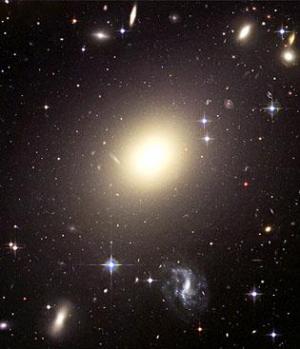Limit the maximum size of the black hole
According to a new study by Yale celestial physicists published in the Royal Astronomical Society's monthly report, there seems to be a maximum limit on the size of the largest black holes. The universe can be achieved.
Once rated as rare and exotic objects, black holes are now thought to exist throughout the universe, with the largest black hole found at the center of the largest galaxies. 'Super-big' black holes are thought to be 10 billion times larger than the Sun. Priyamvada Natarajan, professor of astronomy and physics at Yale University and a colleague of the Radcliffe Institute, affirmed that even the largest black holes could not expand forever. Instead, these space monsters seem to suppress their development when they reach 10 billion times the mass of the Sun.
Ultra-large black holes, discovered at the center of a giant elliptical galaxy in large galaxy clusters, are the largest in the universe. Even the black hole at the center of our Milky Way galaxy is 100 times smaller than those giant monsters. However, giant black holes, increasing in size by drawing matter from nearby gas, dust and stars, seem to be unable to exceed the magnitude limit regardless of where or at the time. they appear in the universe. Natarajan said: 'It does not happen at this time. In every era of the universe, there are times when they stop. '

The researchers found that supermassive black holes, hidden in the center of the galaxy cluster as large as in the image, have an upper limit of size, about 10 billion times the size of the Sun.(Photo: NASA).
The study, published in the Monthly Report of the Royal Astronomical Society (MNRAS) on October 15, first determined the maximum size limit for black holes. Natarajan used X-ray and optical data of supermassive black holes to show that, in line with the many observations collected, the black hole needed rest periods during its evolution.
Another explanation given by Natarajan is that the black hole will eventually reach the time when it emits too much energy because it absorbs what's around. The black hole will interfere with the source of the gas they absorb, which may disrupt the nearby star formation process. The new findings are significant for future research on galaxy formation, because many galaxies in the crop seem to co-evolve with the black hole at the center. Natarajan said: 'Many evidence has been given about the essential role of black holes in galaxy formation. However, it seems they are the main actress in the universe's opera. '
The author of the paper includes Priyamvada Natarajan (Yale University and Radcliffe Academy for research advancement) and Ezequiel Treister (Southern European Observatory, Chile and University of Hawaii).
- Video: Compare the size of black holes in the universe
- Detecting a small, black hole,
- Black holes can be 50 billion times more massive than the Sun.
- The black hole can only expand to 50 billion times the mass of the Sun, it is impossible to 'eat to grow'
- The giant black hole was first measured
- Discovered the unknown type of black hole
- Discover the mystery of the most exotic black holes in the universe
- What if a black-sized black hole attacked the Earth?
- The smallest black hole has ever been recorded
- 740 million light years away is a completely different universe of black holes
- Discovering 'super black holes' is 12 times bigger than the Sun.
- Evidence of the power of black holes
 Van Allen's belt and evidence that the Apollo 11 mission to the Moon was myth
Van Allen's belt and evidence that the Apollo 11 mission to the Moon was myth The levels of civilization in the universe (Kardashev scale)
The levels of civilization in the universe (Kardashev scale) Today Mars, the sun and the Earth are aligned
Today Mars, the sun and the Earth are aligned The Amazon owner announced a secret plan to build a space base for thousands of people
The Amazon owner announced a secret plan to build a space base for thousands of people